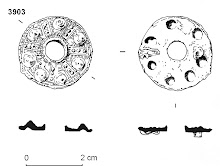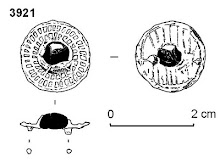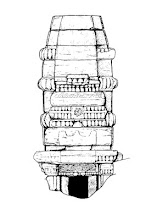At the close
of the week we were still excavating late 16th century
deposits within the test-pit sited over the City ditch; the adjacent borehole
records further deposits beneath these which should date to the disuse of the
ditch in the late medieval/Tudor period. John Stow records in the Survey of
London that the entire City ditch was ‘cleansed’ in 1477, and that parts of the
wall were repaired in brick at the same time. Sections of those brickwork
repairs, including ‘diaper’ patterned decorative work, are still visible at St
Alphege on London Wall.
At the same time the maintenance of the wall (and presumably the ditch) was divided up between the City Guilds to try and ensure the fabric of the walls was maintained and the ditch was kept clean and open. Refuse disposal into the City ditch was an ongoing problem in the medieval period, with the nearby streetname ‘Houndsditch’ graphically indicating the problem with the ditch being used as a rubbish dump. Once active cleansing of the ditch had stopped the rubbish would have piled up and the ditch became a useful tip.
How long the cleansing of 1477 lasted is not known, but the deposits
within the ditch may be able to indicate the point at which the ditch stopped
being cleansed, how quickly the ditch became used for rubbish disposal, and the
point at which the ditch ceased to exist as a civic defence and became
effectively a landfill site. The deposits and associated artefacts may also indicate the type of rubbish disposal -domestic refuse, industrial waste or demolition material. The deposits should also indicate if and when there
was a concerted effort to level the ditch, or whether this was ad hoc until the Crescent groundraising of the 1760s.
East of the ditch the test pits along Minories are revealing a post-medieval landscape of brick buildings, yards and gardens. Only further excavation will show how these properties, and the activities carried out within them, relate to the former City ditch to their rear
East of the ditch the test pits along Minories are revealing a post-medieval landscape of brick buildings, yards and gardens. Only further excavation will show how these properties, and the activities carried out within them, relate to the former City ditch to their rear














No comments:
Post a Comment